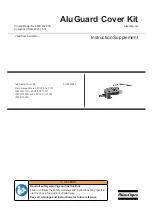
6
D-31 June 2002
Very low humidities have, in the past, caused film
to be brittle. However, film of current manufacture
has not been found to exhibit brittleness or
breaking tendencies under normal handling,
even at relative humidities as low as 15%. Old film
that is found to be brittle at low humidity should
be reconditioned to a higher humidity before
use. One day’s storage is usually sufficient for
conditioning a dry 16 mm roll halfway to a higher
ambient relative humidity; to bring it to full
equilibrium requires about a week. In each case,
both sides of the roll should be exposed to the air.
Rate of conditioning a typical safety film from 20% to 50%
relative humidity at 21°C (70°F).
Low humidity affects the curl of silver-gelatin film,
causing a slight contraction of the emulsion layer
and resulting in a slight curl toward that side.
This is generally believed to be an advantage
because the concave emulsion surface is better
protected against abrasion. However, excessive
curl may cause difficulty in focusing images in
some microfilm readers. This can be avoided
by conditioning the film to a relative humidity of
30-50% before use. The curl of diazo, TPS, and
vesicular films is virtually unaffected by humidity.
Film handled at very low humidities may also
develop a static charge as it passes through a
reader or rewinder. This static charge will attract
dust particles that can damage the emulsion by
chemical action or physical abrasion. Therefore,
it is important that any film handling area be kept
clean. If film is kept in a dry storage area, it may
be necessary to use the film in an office area of
higher humidity to minimize static problems.
However, as previously noted, large humidity
differences may lead to conditioning problems.
Molecular Sieves
Molecular sieves are capable of absorbing most
of the potential film degradation agents such as
moisture, oxidants, solvents, and others when
kept in close proximity with the films under
confined storage.
24
Therefore, Eastman Kodak
Company recommends the use of molecular
sieves with triacetate and polyester-based films to
reduce the physical aging of films and increase
the longevity of black-and-white images under
confined storage. It also prevents ferrotyping
(mold/fungal growth on films), as it reduces the
moisture content of film.
Tests have shown that molecular sieves prevent
vinegar syndrome associated with acetate-based
films and micro-blemishes, and arrests the
oxidation of silver images due to peroxides and
ozone in the atmosphere. Using molecular sieves
slows the rate of these degradation reactions
under confined storage and thus extends the
keeping and longevity of older film collections.
A single molecular sieve packet inserted into the
existing flip-top boxes containing microfilm will
last for five to seven years, under recommended
storage conditions. Microfilm should be inspected
periodically to offer an opportunity to replace
the molecular sieves.
The sieves must be replaced at some interval,
depending on storage conditions. The use of
molecular sieves is cited by the American National
Standards Institute (ANSI) as another procedure
to reduce redox blemishes caused by high
humidity conditions and oxidants in the air. For
more information or to obtain molecular sieves
(listed below), call Multisorb at 1-800-445-9890.
With or without molecular sieves, it is very
important to follow current industry recommended
practices for film storage, such as keeping film
under proper temperature and relative humidity
conditions. However, placing recommended
amounts of molecular sieves inside flip-top
boxes will extend the life of the films significantly.
This adds additional protection by slowing the
deterioration process.
Molecular Sieves
Part No.
Film
Format
Content
41 ag 43
16 mm
3.5 grams
400
41 ag 47
35 mm
7.0 grams
200
41 ag 51
105 mm
12.5 grams
125








































